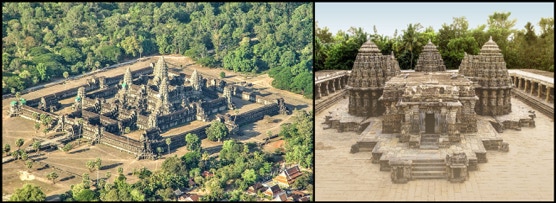
I. AN EMMANATIVE COSMOLOGY
Few if any architectural traditions attempt so systematically, yet inventively, to recapitulate a “creation myth” or cosmogenic metaphor in the design of their sacred building as the Karnata Dravida and Khmer. The starting point of Hinduism’s “emanative ontology” 2 could be said to be a non-manifest, apophatic absolute, described as both nirguna, “without properities” or “attributes,” indivisible, and niskala, “without form or size,” imperceptible and incomprehensible - a cosmic essence both immanent in all things and transcending them. This non-theistic divinity first manifests itself as formless consciousness, descending gradually into the material forms of the empirical universe, diluted in direct proportion to its distance from its incorporeal source. A similar degeneration can be found in Western thought, for example, the decay of the eternal Platonic forms or noumena into transient phenomena o the descent of medieval scholasticism’s “Great Chain of Being.”
Thus, a continual resonance could be said to exists in Hindu ontology between the manifest and non-manifest, between an expanding periphery and its dimensionless center, between palpable illusion and gnostic reality. Emanations must, accordingly, both be seen and seen through to their invisible source. In advaita, non-dualist, Hindu and Buddhist schools, these are just two aspects or moments of the same unitary, indissoluble absolute whose manifestations, paradoxically, occlude it. This emanative cosmology permeates Hindu mythology, dharma or doctrine and architecture. In one account, the Aum, the primordial sound or tri-syllable, reverberates not through the universe but the universe itself, ringing out from Vishnu’s shankha, conch, calling entropic chaos to order. Similarly, the bindu, the originary “seed,” commemorated by the red dot on the forehead of the devout, represents the primal “drop” into being, rippling out in concentric circles of more diffused divinity. Analogies echo in many creation mythologies, not least Mosaic theologies’ “all-creating word,” which was also in the beginning before time.
In Hindu architectural practice, including the Khmer and Karnata Dravida traditions, the prasat, vimana or shrine is comprised of a garbhagriha (Sans.> garbha womb + griha chamber, sanctum, cella or naos) and shikhara, “mountain peak” or superstructure, rising above it. They are given dimension according to a regulating grid or mandala, emanating from a central point (or square) which is applied by an architect, the sthapati, in concert with a priestly consultant, the sthapaka. 3 This vimana or shrine is conceived as an icon or simulacrum of Mt. Meru, the holy mountain at the center of the universe, which does not so much rise from the terrestrial plane as spill creation around itself, like the Aum and bindu. Originally ho2e to the prasadas (Sans.> palace, but also temple) of the Vedic pantheon of Indo-European sky deities, like the Greek gods ensconced on Mt Olympus or Germanic on Valhalla, it was moated by six oceans and six mountain ranges where, at a judicious distance, humans dwelled on a distant, triangular continent pointing south. Fig 2
